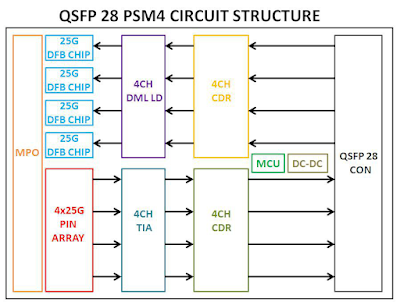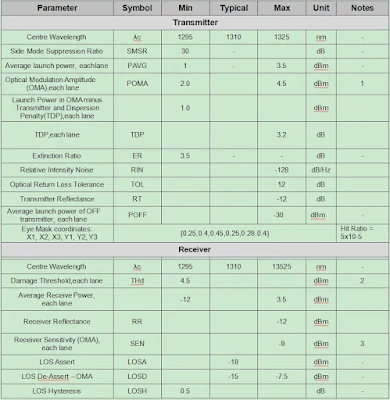With the growing demand for bandwidth from fast-growing cloud services and data centers, 100G networks are growing rapidly. It is reported that by 2019, 100G Ethernet will make up more than 50 percent of data center optical transceiver transmissions which makes 100G transceivers very popular in the future market. Generally, 100G transceivers include CFP/CFP2/CFP4, CXP and QSFP28 transceivers. Among them, the QSFP28 transceiver is the dominant 100G transceiver for now and future. What is QSFP28 transceivers? This article will introduce related knowledge.
Definition of QSFP28 Transceiver
The QSFP28 standard is designed to carry 100 Gigabit Ethernet, EDR InfiniBand or 32G Fibre Channel. This transceiver type is also used with direct-attach breakout cables to adapt a single 100GbE port to four independent 25 gigabit ethernet ports (QSFP28-to-4x-SFP28). Sometimes this transceiver type is also referred to as “QSFP100” or “100G QSFP” for sake of simplicity. QSFP28 transceiver uses four lanes for 100G optical signal transmitting like 40G QSFP+. However, each lane of QSFP28 can transmit 25G optical signal. To fit the various requirements in practical applications, IEEE and MSA standards that support different transmission distances and fiber types are being published.
Types of QSFP28 Transceiver
- 100G QSFP28 SR4
- 100G QSFP28 LR4
100G QSFP28 LR4 is a 100Gb/s transceiver module designed for optical communication applications compliant to 100GBASE-LR4 of the IEEE P802.3ba standard. The module converts 4 input channels of 25Gb/s electrical data to 4 channels of LAN WDM optical signals and then multiplexes them into a single channel for 100Gb/s optical transmission. Reversely on the receiver side, the module de-multiplexes a 100Gb/s optical input into 4 channels of LAN WDM optical signals and then converts them to 4 output channels of electrical data.
The central wavelengths of the 4 LAN WDM channels are 1295.56, 1300.05, 1304.58 and 1309.14 nm as members of the LAN WDM wavelength grid defined in IEEE 802.3ba. The high performance cooled LAN WDM DFB transmitters and high sensitivity PIN receivers provide superior performance for 100Gigabit Ethernet applications up to 10km links and compliant to optical interface with IEEE802.3ba Clause 88 100GBASE-LR4 requirements. This product is designed with form factor, optical/electrical connection and digital diagnostic interface according to the QSFP+ Multi-Source Agreement (MSA). It has been designed to meet the harshest external operating conditions including temperature, humidity and EMI interference.
- 100G QSFP28 PSM4
It is a Four-Channel, Pluggable, Parallel, Fiber-Optic QSFP28 PSM4 for 100 or 40 Gigabit Ethernet , Infiniband DDR/EDR Applications. This transceiver is a high performance module for data communication and interconnect applications. It integrates four data lanes in each direction with 104Gbps bandwidth. Each lane can operate at 26Gbps up to 2km over G.652 SMF. These modules are designed to operate over singlemode fiber systems using a nominal wavelength of 1310nm. The electrical interface uses a 38 contact edge type connector. The optical interface uses an 12 fiber MTP (MPO) connector.
Figure1. Module Block Diagram
100G QSFP28 PSM4 is one kind of parallel transceiver. DFB and PIN array package is key technique, through I2C system can contact with module.
Figure2. Optical Characteristics
Note:
1.Even if the TDP<1dB,the OMA min must exceed the minimum value specified here.
2.The receiver shall be able to tolerate, without damage, continuous exposure to a modulated optical input signal having this power level on one lane. The receiver does not have to operate correctly at this input power.
3.Sensitivity is specified at 5×10^-5 BER at 25.78125Gb/s.
- 100G QSFP28CWDM4
QSFP28 CWDM4 is a 100Gb/s transceiver module designed for optical communication applications compliant with the QSFP MSA,CWDM4 MSA and portions of IEEE P802.3bm standard. The module converts 4 input channels of 25Gb/s electrical data to 4 channels of CWDM optical signals and then multiplexes them into a single channel for 100Gb/s optical transmission. Reversely on the receiver side, the module de-multiplexes a 100Gb/s optical input into 4 channels of CWDM optical signals and then converts them to 4 output channels of electrical data.
The central wavelengths of the 4 CWDM channels are 1271, 1291, 1311 and 1331 nm as members of the CWDM wavelength grid defined in CWDM4 MSA. The high performance Uncooled CWDM DFB transmitters and high sensitivity PIN receivers provide superior performance for 100Gigabit Ethernet applications up to 2km links .
This product is designed with form factor, optical/electrical connection and digital diagnostic interface according to the QSFP+ Multi-Source Agreement (MSA). It has been designed to meet the harshest external operating conditions including temperature, humidity and EMI interference.
Figure1. Module Block Diagram
Figure2. Eye Mask
Application of QSFP28 Transceiver
From above table, you can get the information that the cable type, interface type, fiber count and reach are needed to be considered when purchasing transceivers. For example, in the terms of reach, except the shortest (QSFP28 SR4) and the longest (QSFP28 LR4), PSM4 and CWDM4 are battling out in the 2km range.
Summary
In order to satisfy different 100G network transmission applications, various of 100G interfaces are developed. How to choose the apposite one? It is totally determined by your demands. For short distance transmission over multimode, 100Gbase-SR4 QSFP28 module is suggested. For single-mode applications, 100Gbase-PSM4 supporting 500m, 100Gbase-CWDM4 supporting 2km and 100Gbase-LR4 supporting 10km are available. If you want to know more, welcome to visit infiberone.com.







Post a Comment